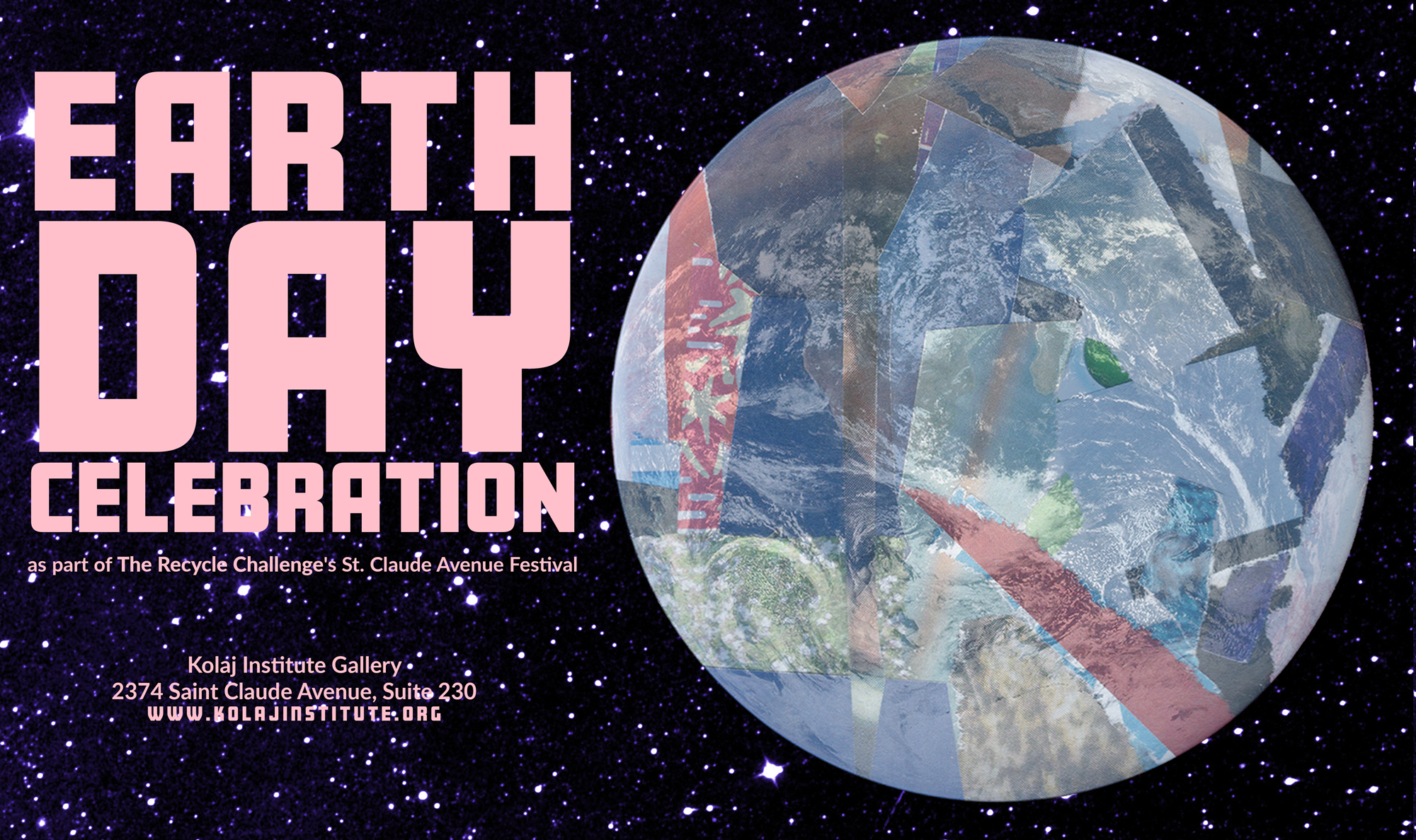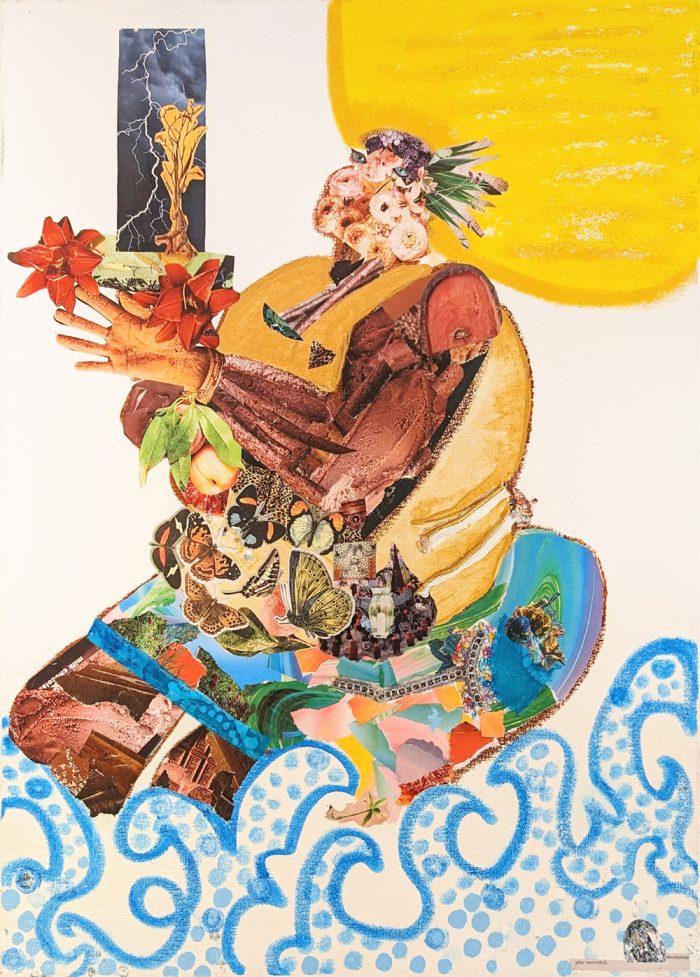
COLLAGE ON VIEW AND EARTH DAY CELEBRATION
Collage the Planet: Environmentalism in Art
at Kolaj Institute Gallery in New Orleans, Louisiana, USA
19 April to 26 May 2024
Gallery open by appointment.
Earth Day Celebrations at Kolaj Institute
Saturday, 20 April
The Recycle Challenge Parade, 10:30AM-Noon
Sunday, 21 April
Curator & Artist Talk, 1-2PM
Crafting Costumes with Recyclables Workshop, 4-6PM
In honor of Earth Day 2024, Kolaj Institute is hosting a series of events as part of The Recycle Challenge’s St. Claude Avenue Festival. On Saturday, 20 April 2024, members of the Mystic Krewe of Scissors & Glue and participants in the Collage the Planet Artist Residency will join the The Recycle Challenge Parade (10:30AM to Noon) as it passes by the corner of St. Claude and St. Roch Avenues. On Sunday, 21 April 2024, the gallery will be open from Noon to 6PM where the exhibition, “Collage the Planet: Environmentalism in Art”, will be on view. The premise of the exhibition is that while science has the capacity to tell us how to care for the planet, those solutions are meaningless if humanity doesn’t care enough to evolve and change. Art is a unique technology that can distill complexity into simple human gestures that, when experienced, facilitate a deeper understanding of our world. The exhibition shows examples of artwork that speaks to environmental issues and offers us an opportunity to intellectually and emotionally foster a healthy relationship with the natural world. A Curator & Artist Talk will take place from 1PM to 2PM. From 4PM to 6PM, The Recycle Challenge will host a free workshop, “Crafting Costumes With Recyclables.”

24″x18″; oil pastel, acrylic paint, found images, ribbon/cord, gems, and fabric; 2022. Courtesy of the artist.
ABOUT THE EXHIBITION
The health and wellbeing of our planet is a primary concern of a majority of adults1 in the United States and yet the complex social, political, and economic dynamics that shape our discourse around the environment can leave one feeling confused and powerless. How do we sort through such complexity and develop an understanding for ourselves of what an ethical and healthy relationship with the natural world could be? What is the relationship between our individual choices and the systemic change needed to bring humanity’s relationship with the natural world into harmony? How do we move beyond rhetoric, cliche, and performative actions and towards meaningful change?
The premise of the exhibition “Collage the Planet: Environmentalism in Art” is that science has the capacity to tell us how to care for the planet, but those solutions are meaningless if humanity doesn’t care enough to evolve and change. Art is a unique technology that can distill complexity into simple human gestures that, when experienced, facilitate a deeper understanding of our world. The exhibition shows examples of artwork that speaks to environmental issues and offers us an opportunity to intellectually and emotionally foster a healthy relationship with the natural world.
Californian artist Jana Zimmer similarly wrestled with portraying the devastation of climate change, using abstraction as a technique to connect a recent oil spill near her town to her family’s history of the Holocaust.
A diptych by Frederick, Maryland artist Liz Aukamp LaGarde draws a connection between pristine green lawns, the childhood memory of catching lightning bugs, and the lack of biodiversity that prevents those memories from being passed down to future generations.
Informed by the surrealism of a chaotic uncertainty, Matauri Bay, Kaeo, New Zealand artist Teresa HR Lane “reimagines a world where the fragility of man is finely balanced against the strength of nature, reminding man that perhaps they do not have complete autonomy over this planet, but they too are just one of the many vulnerable.”
New Orleans artist Jill Stoll‘s “Consumer Cloth Project” asks, “How can we reconcile our addiction to consumerism and be safekeepers of our planet at the same time?” Stoll collects cardboard waste from “bodegas and restaurant dumpsters”, trolls “the neighborhood on garbage days”, and processes this material into strips which she weaves into artworks on an improvised loom of push pins, binder clips, and glue.
Moira Crone, artist and award-winning author, is “inspired by the complexities of vision and sound in New Orleans” and in her work “the interpenetration of humans and their environment is a constant theme.”
Food deserts typically refer to urban areas in which it is difficult to buy affordable or good-quality fresh food. Christopher Kurts asks us to consider what will happen when the planet becomes a food desert. His collages speak to “the cyclical nature of our relationship with Earth’s resources requires us to take care of that which takes care of us.”
Intuition by LaVonna Varnado-Brown is a meditation on mother earth. The artist writes, “This piece is about healing and grounding. She’s holding herbs/roots and lightning. She embodies the abundance at rest between the earth and sky.”
In the series, “Studies for a New Planet”, Ric Kasini Kadour presents spherical, abstract collages that meditate on the colonization of new planets. Is the implication that Earth is replaceable? Would we export to new worlds the same social, political, and economic dysfunctions that are making our planet uninhabitable?
Trained as a geographer, Daniela Ruiz Perez uses maps to showcase conservation issues of animal species in her home community of the Chesapeake Bay area. In March, she spent two weeks as Artist-in-Residence at Kolaj Institute in New Orleans where she researched the wetlands of Louisiana and made artwork about the Black Rail bird, a sentinel species of environmental collapse.
Artworks from invited artists will be joined by collage made during the Collage the Planet: Environmentalism in Art Artist Residency where artists from across North America spend five days in New Orleans exploring how they adapt their artist practice to speak to the complexities of environmental issues and contribute to a broader dialogue on sustainability and ecological consciousness.
The exhibition coincides with The Recycle Challenge Parade and Festival. In celebration of Earth Day, the four-day festival presents workshops, activities, live music, food, interactive exhibits, and two walking parades “that highlight the creativity and dedication of local businesses and residents when it comes to recycling and taking care of our planet.” The public is invited to participate in a walking parade on Saturday, 20 April that traverses through the Marigny, St. Roch, and French Quarter neighborhoods. On Sunday, 21 April, Kolaj Institute’s Studio and Gallery will be open to the public as part of the festival taking place in the neighborhood.
The exhibition and artist residency, “Collage the Planet: Environmentalism in Art” is part of Kolaj Institute’s project, Politics in Collage, a series of residencies, publications, discussions, and exhibitions examining complex socio-political issues that contemporary society is contending with, in order to spark meaningful dialogue and inspire deeper engagement.
The exhibition is curated by Ric Kasini Kadour, a 2021 Andy Warhol Foundation for the Visual Arts Curatorial Fellow, writer, artist, publisher, and cultural worker. This exhibition represents the twentieth exhibition he has curated since 2017 at museums, galleries and other venues in Ireland, Louisiana, Scotland, Tennessee, Vermont, and Wisconsin. Kadour is also the co-founder, editor and publisher of Kolaj Magazine. He maintains an active art practice and his photography, collage, and sculpture have been exhibited in and are part of private collections in Australia, Europe and North America.
INFORMATION
Kolaj Institute Gallery
Suite 230
2374 Saint Claude Avenue
New Orleans, Louisiana 70117 USA
Hours:
Sunday, 21 April, Noon-6PM
and by appointment
- https://www.pewresearch.org/short-reads/2023/08/09/what-the-data-says-about-americans-views-of-climate-change/ “a majority of U.S. adults (54%) describe climate change as a major threat to the country’s well-being.” ↩︎
